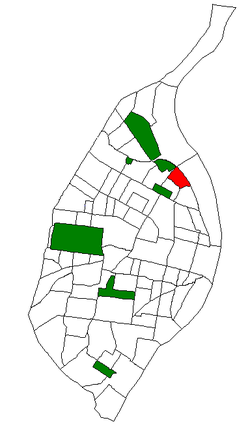College Hill, St. Louis
| College Hill | |
|---|---|
| St. Louis neighborhood | |
 Location of College Hill within St. Louis |
|
| Country | United States |
| State | Missouri |
| City | St. Louis |
| Wards | 2, 3 |
| Government | |
| • Aldermen | |
| Area | |
| • Total | 0.39 sq mi (1.0 km2) |
| Population (2010) | |
| • Total | 1,871 |
| • Density | 4,800/sq mi (1,900/km2) |
| ZIP code(s) | Part of 63107 |
| Area code(s) | 314 |
| Website | stlouis-mo.gov |
College Hill is a neighborhood of St. Louis, Missouri. The name College Hill was given to this area because it was the location of the St. Louis University College Farm. This area, bounded generally by Warne (O'Fallon Park, I-70, Grand Boulevard and West Florissant was acquired by the University for garden and recreation purposes in 1836. It was subdivided in the early 1870s. The Bissell Mansion, the Old Water Tower at 20th Street and East Grand Avenue, and the Red Water Tower at Bissell Street and Blair Avenue are mainstays in this old Northside neighborhood and are testimony of a rich historical heritage. The housing of this neighborhood dates back between 1880 and 1920. Townhouses and four family flats predominate the neighborhood, with a mixture of single family brick dwellings. The houses have large yards and are ideal for landscaping. The homes located near the crest of the hillside bluff enjoy a view of the river and its valleys. Nearly half of the housing dwellings are owner-occupied. Historically the area's commercial center has been concentrated along East Grand around the Old Water Tower with a strip along West Florissant.
The largest land owner in the area was Colonel John O'Fallon, whose holdings of over 600 acres (2.4 km2) embraced the present O'Fallon Park. This was the site of the mansion. It was said that during excavations for its foundations during the 1850s that Indian and mound builder's artifacts were discovered. The house was quite large and contained more than fifty rooms in its four stories. Colonel O'Fallon was born in Kentucky in 1791 and came to St. Louis as a young man to work as an Indian agent under his uncle, General William Clark.
After making a fortune in the Indian trade, O'Fallon purchased the large tract on Bellfontaine Road. He chose the highest point on the property for the location of his mansion which he named "Athlone" after his father's Irish birthplace. Keeping the present park sit as his estate, O'Fallon sold off the remainder at a large profit. He augmented his fortune in railroading and banking and later donated one million dollars to local schools and colleges. Following Colonel O'Fallon's death in 1865, the estate was sold to the city for a park in 1875 for $260,000. The mansion was partially burned in the same year and was razed in 1893.
...
Wikipedia
